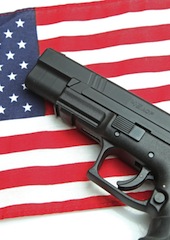Slavery and Guns: America’s “Peculiar Institutions”
How are U.S. “gun rights” today an extension of a right created to preserve slavery?
August 31, 2013

In the United States we are now more than eight months past a gun-death sympathy surge and have little to show for it. All we have seen is incremental reform in a few small states, symbolic reform in a few other states — and nothing in the nation as a whole, beyond the exercise of marginal presidential prerogatives.
In short, our nation’s status along the gun-mediated injury front remains both grim and curious.
In the meantime, we Americans have accomplished the following:
- We have normalized sudden death and life-long crippling as typical outcomes of street-corner discourtesies.
- We have accepted suicides, murder-suicides, mass murders and mass-murder-suicides as “isolated incidents” or “random events” — or as signs of personal pathologies beyond the reach of law.
- We have refined mourning-and-healing protocols and expect to refine them further.
- We have subordinated the supposedly unrealistic “never again” to the reliably anodyne “coming together” and “moving on.”
- And we have just learned, from Florida’s Zimmerman-and-Martin case, that an armed man challenging an unarmed boy, who challenged back, could legally shoot to kill if losing the fight he had started.
From less violent societies abroad, friends watch in somber wonderment. They sense something exceptionally American, but not knowing what to call it or how to understand it.
The particulars here are new, but the emotional substance old. The latter, the emotional substance, has long been available for radicalization, but most attempts to use it for that purpose have failed. Two successes, separated by many generations, bear telling similarities.
The prior case of radicalization was shrouded in patrician gentility. An elegant euphemism, “our peculiar institution,” was used to explain, even promote, and ultimately defend its operative concept, American race slavery.
For nearly 200 years, when bondage was commonplace north and south, such a euphemism had hardly been needed. But as slavery in the United States grew more profitable and more limited to one region, the phrase came increasingly into service.
Barely past the peak of its power and against most predictions, slavery was slain in 1865. After another century, its successor regime — appearing first as Liberation, then Jim Crow, then Massive Resistance — was slain, too, with the Civil Rights Act of 1964. Nowadays public figures expressing any hint of regret at these events risk their reputations and may lose their careers.
Guns, Courts and Slaves
The case of current radicalization is cast as plebeian self-reliance. Elegant it is not, nor is it euphemistic. “Gun rights in danger!” is more its style. And, to be clear, its relationship to slavery is old and cold, even ambiguous.
Yes, the state militias whose good regulation needed arms to be held throughout the free white male citizenry would have responded to uprisings — very rare ones — by slaves in the settled south.
They would have done so, too, in response to depredations by tribesmen in the unsettled west, to rebellions by farmers — such as Shays’ Rebellion in Massachusetts — or to encroachments by foreign powers into any state or adjacent territory.
More revealing has been the transformation of the underlying threat perspective: We have moved our sense of precaution from a focus on ensuring public safety against the imagined future meddling of a central government to one endangering public safety. How did we do that? By accepting that almost any adult may have and use almost any firearm.
The commonality — what makes “gun rights” the re-embodiment of “our peculiar institution” — is what today might be called a pre-traumatic stress syndrome: hyper vigilant fixation on the citizen’s relationship to government and government’s relationship to the citizen’s property.
During the prior case of radicalization, this relationship changed drastically — and in the property owner’s favor. Lord Mansfield’s 1772 King’s Bench ruling in Somersett v. Stewart freed a slave, James Somersett, who had been bought in Boston and brought to England, where he escaped and was recaptured. No law allowed slavery in Great Britain and the judge ruled “the black” a free man.
This precedent mattered not at all in British colonies that did allow slavery. The U.S. Constitution later clearly protected slavery — without including any form of that word, which the Founders lacked the nerve to use.
Chief Justice Roger Taney’s notorious 1857 majority opinion in Dred Scott v. Sandford did consider Somersett, although by then a foreign precedent, but found reason to ignore it both as letter and spirit.
Seven of nine Supreme Court justices had come to concur — 85 years after James Somersett had become a free Englishman and 66 years after the Bill of Rights had entered the U.S. Constitution — that the freedom to own could outweigh freedom itself.
During the current case of radicalization, the freedom to own guns has come to outweigh freedom from a poorly regulated militia. That is to say individual unordered civilians can have and use military weapons, even when not “bearing” them as a soldier.
This transition, which required an eccentric reinterpretation of the Constitution’s Second Amendment and culminated in the broader holdings of District of Columbia v. Heller (2008).
This case followed a long exertion of political force on the nomination and confirmation of pro-gun federal judges and Supreme Court justices and on politicians seeking election to, and prolonged employment in, Congress.
This freedom-to-own theme is both a liberal idea — one that was crucial in liberalism’s long campaign against tyrannical monarchy — and a libertarian idea, even though one stretched to extremes on libertarianism’s anarchical fringe. Freedom-to-deny-freedom was as extreme as this notion has ever gotten and that extreme was exalted in “our peculiar institution.”
The gun-rights embodiment of this notion is less extreme only insofar as civilians’ weapons are used for fun or defense and never for assault. Of course, that condition is violated many thousands of times each year within the borders of the United States.
Around these central consistencies are found other similarities. Arguable evils became positive goods. More slavery, more civilization. More guns, more safety.
States Vs. Feds
Such peculiar freedom requires serious gagging. Consider, for example, that provisions in federal law, including the Patient Protection and Affordable Care Act of 2010 (“Obamacare”), block federal funding for gun-violence research.
And a law enacted in Florida in 2011, but stayed by a federal court order, would forbid routine “any-guns-in-the-house?” questioning by physicians — despite the question’s health care value.
Even more obvious have been state-level “nullification” bills — proposed, passed or even signed into law. These criminalize the enforcement of federal statutes.
The bills violate the supremacy clause of the U.S. Constitution. They are just as absurd as in 1832 when South Carolina passed its “Ordinance of Nullification” and threatened secession if the federal government dared to respond.
That dispute pitting Vice President John C. Calhoun, South Carolina’s arch-nullifier and the most eloquent of “peculiar institutionalists,” against President Andrew Jackson.
The trigger/underlying cause in 1832 had been a tariff protecting northern manufacturing interests and harming southern plantation interests. The federal threat had not been to slavery itself, but to economies based on exports harvested by slaves.
The causes today seem more various, but common among them is a fevered prospect Calhoun would have recognized in an instant.
The charge is always that an overweening federal government might through some future law intentionally oppress the populace. The presumable way by which it does about this is, first, by disarming them, and then in myriad ways de-culture them — even, God forbid, secularize them.
But hats off to the 19th century Calhoun for having the audacity to spell out his arguments.
On July 5, 2013, the governor of Missouri, a Democrat named Jay Nixon, vetoed an act, which had been passed with bipartisan support by Missouri’s legislature. By state statute, it would have criminalized the enforcement of federal gun laws by federal agents and would further have criminalized the publication of any gun owner’s name.
The governor’s explanation for standing up against these absurd provisions, as reported by the Associated Press, was studiously folksy: “Under this bill, newspaper editors around the state that annually publish photos of proud young Missourians who harvest their first turkey or deer could be charged with a crime.”
Audacious, no. Facile, yes. Clever, too.
Governor Nixon found a politically safe way to veto an absurd attempt to ignore the supremacy clause of the U.S. Constitution or freedom of the press. He ostensibly sought to honor his state’s — our country’s — new peculiar institution of virtually unregulated gun use.
A passive majority has been out-maneuvered and out-fought by an assertive minority on the issue of guns in the United States. Democracy allows this, but it also allows comebacks. The majority can accept policies as given, or it can resolve through long concerted effort to change them.
We await our own decision.
Takeaways
In the early US, arguable evils became positive goods. More slavery, more civilization. More guns, more safety.
On gun laws, a passive majority has been out-maneuvered and out-fought by an assertive minority.
The majority can accept policies as given or it can resolve through long concerted effort to change them.
In Florida, an armed man could legally shoot to kill if losing the fight he had started.
Today, freedom to own guns has come to outweigh freedom from a poorly regulated militia.
Read previous

Syria: Lessons from History
August 31, 2013
